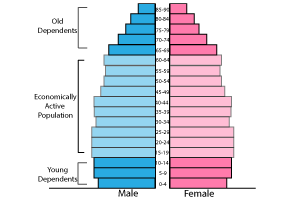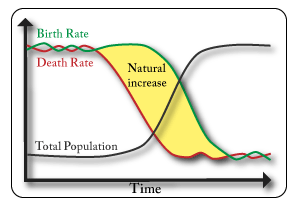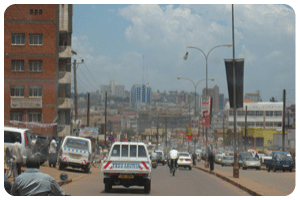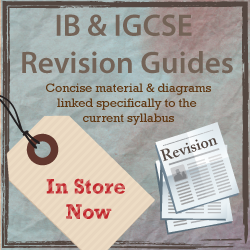
Distribution and Density
Population distribution is how people are spread out & this can be considered on any scale. People are distributed around the globe but the population density varies considerably.
Population density refers to hao many people live in a given area (usually km or mile square. Areas with fertile soil, good climate and reliable water supplies tend to be densely populated. Areas that have extremes of temperature, steep land, unreliable water supplies and poor soils tend to be sparsely populated.
Population Pyramids
Population pyramids show the sex & age make up of a countries population and are very useful for comparing countries. The shape of a countries pyramid can give us a clue about the level of development in the country.
LEDC pyramids typically have wide bases due to high birth rates. A classic pyramid shape due to a high death rate at all ages. They are short due to relatively low life expectancy.
MEDC pyramids tend to be narrow at the base (low birth rate) and remain a similar shape up to the ages of 65+ due to a low death rate through these ages. The pyramid is often tall due to long life expectancy.


Demographic Transition Model
This is a model that shows how a countries population typically changes over time as it develops.
- Initially high birth and death rates: poor healthcare, diet, families are large, limited contraception.
- Death rates fall as health care improves but the birth rate remains high. This causes population growth through natural increase.
- Birth rates fall: lower infant mortality, family-planning, contraception.
- Stable population: low birth & death rates.
- Some MEDC countries are now facing declining populations as the birth rate falls below the death rate due to low fertility rates and higher death rates (aging populations).

Internal Migration
This is mmigration which occurs within countries.
LEDCs are experiencing rapid rural to urban migration as they industrialise.
MEDCs are experiencing counter-urbanisation as people move to more pleasant and peacefull locations.
Rural to Urban Migration
This is the movement of people from the countryside to the cities.
Push factors
- Mechanisation of agriculture is reducing jobs in farming.
- There are a limited range of job options and most are low paid.
- There is normally no access to higher education (universities).
- Poor service provision (internet & cellphone).
Pull factors
- Wide range of well paid job options (IT, media, politics, finance etc).
- Entertainment & leisure facilities (theatres, cinemas, restaurants, nightclubs etc)
- Universities and colleges.
Counter-Urbanisation
This is the movement of people out of the cities to the surrounding rural areas. The internet and telecommunications technology are changing the nature of business locations and remote working.
Push Factors
- Noise and air pollution
- Traffic congestion
- Higher crime rates
Pull Factors
- Many people work from home so choose a pleasant place.
- Quiet, safe & pleasant environment.
- Larger houses with gardens.



International Migration
This is the movement of people from one country to another to live. There are various reasons why people may migrate internationally & they can be categorised as:
Forced: when people have to leave for reasons such as: natural disasters, war, famine, political persecution
Voluntary: when people choose to leave for reasons such as: climate, jobs, education.
There are often large numbers of migrants from developing countries to developed ones as they seek higher wages and better living conditions. Some examples are Mexicans moving to the USA and Polish migrating to the UK. Migrants that send money back to their home country (remittances) play an important role in redistributing income on a global scale.


